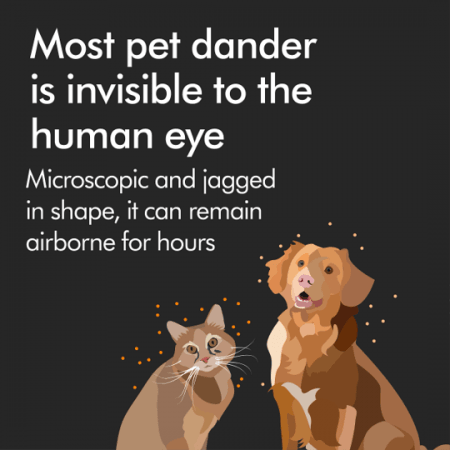Every pet parent understands the challenges of keeping a clean home for the well-being of every family member as well as the overall environment of the home healthy. Experiencing allergic reactions to pets can be difficult to manage. If you're struggling to be around specific animals, you're not alone – however, the Dyson Global Dust Study 2022 states that pet owners are often unaware of the hidden impacts of their furry friends. By investigating their cleaning habits, it was revealed that 21% of Indians were unaware that pet allergens that trigger pet-related allergies could be found in household dust.
Dyson explains what causes pet allergies and provides tips for reducing exposure to pet dander and particles, which can help reduce symptoms and maintain a cleaner, healthier home.
What causes pet allergy symptoms?
Signs of allergies can often be a result of exposure to proteins found in pet saliva and dead skin cells, or urine. Pet dander can remain airborne for long periods of time as well as stick to clothing and soft furnishings.

Allergic reactions are caused by an inflammatory reaction in your nasal passages or lungs, as your immune system responds to inhaling the pet dander allergen.2
But what is pet dander?
- Pet dander is composed of tiny, microscopic flecks of skin shed by cats, dogs, rodents, birds and other animals with fur or feathers.
- When pets groom themselves, they deposit minute allergy-causing protein particles on their hair and skin.
- Because of their microscopic size and jagged shape, they can easily stick to furniture, bedding, fabrics and items carried in and out of the home.
By producing the antibodies needed to shield you from foreign substances, your body may overcompensate in reaction to pet allergies, with symptoms including wheeziness, difficulty breathing and asthmatic reactions, sneezing and nasal congestion, eye irritation including itchiness and wateriness, swollen skin around the eyes, chest tightness, insomnia from shortness of breath or coughing, eczema on the surface of the skin or even red patches on the skin and itchiness.2
Which animals cause pet dander allergies?
![[Representational image] allergy](https://data1.ibtimes.co.in/en/full/685023/allergy.jpg?h=450&l=50&t=40)
Any animal with fur can cause a reaction to allergy sufferers, but cats and dogs are the most common. The fur often spreads when you groom your pet, or they groom themselves. Pet dander can remain a trigger even if the pet is no longer in the room.
How to ease symptoms?
If you suffer from symptoms or allergic reactions to pets, below are some options available to help relieve the suffering.
Socialise outdoors with pet owners - The most obvious solution is to avoid being around the cat and dog breeds that cause the most severe symptoms. Ask friends and family to possibly meet outdoors if they're pet owners to avoid being around pet dander and triggering allergens.

Clear dander efficiently –
Using a vacuum cleaner with powerful suction and tools, such as vacuum cleaners can make a real difference. Cordless vacuum cleaners allow you to clean a variety of surfaces easily and freely without the limitations of a cord.
Vacuuming slowly and carefully, working in a pattern and using the right tools, increases the chances of catching pet dander.
Try the Hair screw tool with the Conical brush bar for specialist engineering that tightens strands and removes into the bin in seconds – avoiding blocking your brush bar.
If you frequently travel with your pet in the car, you'll know about pet hair covering surfaces quickly. Pet dander can also commonly shed in your car, so a cordless or handheld vacuum, can make cleaning your car quick and easy.
Finally, washing your pet's bedding frequently can help to remove dander and particles. Washing pet bedding is an important step to remove possible triggers as it is easily transferable.
What if you're an animal lover?
Avoiding pets altogether is a difficult option for animal lovers. India's pet care market is growing rapidly, with nearly one in every six Indians now having a pet, with dogs being the most common. Pets are a great solution to loneliness – but sadly there are no pets that are 100% hypoallergenic.
Choosing a pet that sheds less hair can help, but you can still be exposed to pet dander regularly. Speaking to your doctor will help you to make a decision on how best to manage your allergies with treatments such as antihistamines for milder reactions.

Trust your air
Pollen, dust and dry air all contribute to poor air quality – including pet dander.
An air purifier can be key to supporting your wellbeing. Their prime benefit is to help promote clean, quality air at a healthy level. Engineered to protect you against viruses, allergens and other particles in your home, air purifiers help prevent pollution from entering your airways. Capturing pollen and allergens, the air purifiers purify the whole room and removes 99.95% of ultrafine particles. The activated carbon filter helps capture odours, so combining this technology with the Hair screw tool will help to prevent smells. Choosing Auto mode will activate your purifier as soon as particles are detected, keeping the room purified at all times even when you're busy.
Taking steps against exposure to pet allergens
Fortunately, there are several approaches to help improve your allergen exposure. With these tips and specifically designed machines, reducing exposure to pet dander and particles can help you to reduce symptoms.








